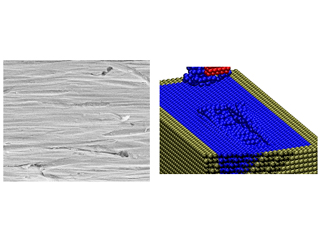Surface finishing with abrasive suspensions
Introduction
Achieving high precision and a high removal rate for post machining processes of complexly shaped surfaces and the cutting of high-perfomance components is a difficult task for leading finising process technologies. This is particular difficult under the consideration of an energy efficient process management in order to achieve a functional surface quality.
Typically applied manufacturing techniques are the abrasive flow machining and waterjet cutting. Abrasive flow machining can be used for the finishing processed of internal surfaces of complex geometries, while waterjet cutting is applied for the separation processes of various classes of materials. Both techniques use fine-grained abrasive particles as processing media and both application technologies possess a high degree of complexity, which is based on the high dynamical interaction of the process medium carrier fluid and the abrasive particles with the workpiece.
The task
Finishing technologies for cleaning or deburring, cutting and ablation of workpieces with complex geometries (e.g. intersecting drillholes) or complex material combination (e.g. fibre composites) is increasingly achieved by the application of abrasive suspensions in the process techniques of abrasive flow machining and abrasive waterjet cutting. For both technologies, there are only a few numerical models available. Typically, these models use considerably simplified assumptions, e.g. the abrasive particles are considered as being a homogenic medium. More realistic approaches which consider the dynamical interaction of individually shaped abrasive particles with the workpiece, are not available at present. However, the optimization of abrasive processes in finishing technologies as the abrasive flow machining and abrasive waterjet cutting can only be achieved by such an explicit treatment of the abrasive particles.
By the combination of various numerical models implemented in the simulation tool SimPARTIX®, the predictability of abrasive processes and the production efficiency of abrasive suspensions in finishing technologies should be ensured. The user of these application should be provided by specific design rules and recommendations for the process kinematics as well as the correct choice of the abrasive medium in order to achieve the best and most cost-efficient result for the finishing process.
Results
In the course of the internally funded project AbraSus of the Fraunhofer Gesellschaft, the simulation tools for the explicit numerical treatment of abrasive suspensions and its interaction with the workpiece have been extended. It is now possible to numerically investigate the importance of rheological properties of abrasive suspensions with different size distributions and varying abrasive grain geometry on the abrasion process on the workpiece and the dynamic interaction with the workpiece on a grain-sized scale. The numerical models can be calibrated for a variety of different material classes in order to distinguish different machining results for different materials.
In the case of abrasive flow machining, the figure below shows a comparison of a manufactured surface and a numerically derived surface feature due to abrasion. In the SEM image, the horizontal grooves are clearly discernible. A similar structure is revealed by the numerical model. Here, the groove of a single abrasive particle is displayed, which has been mechanically formed on the workpiece surface during the dynamical interaction between the impact of an abrasive grain and the workpiece. The ratios between length, width, and depth of the groove are similar to the ones observed in the experiment.
 Fraunhofer Institute for Mechanics of Materials IWM
Fraunhofer Institute for Mechanics of Materials IWM